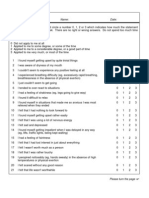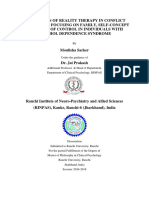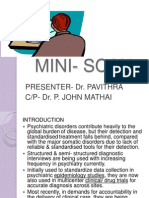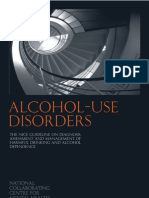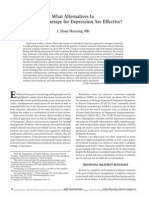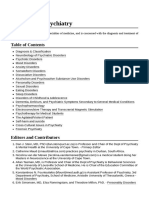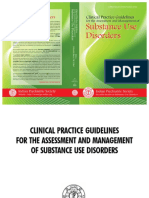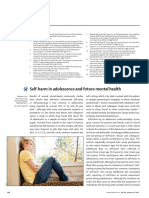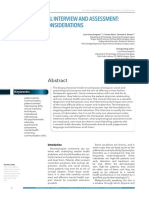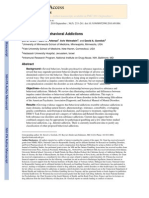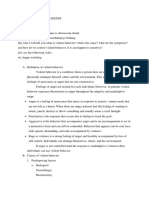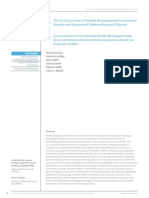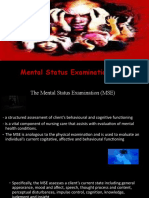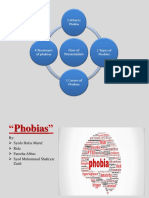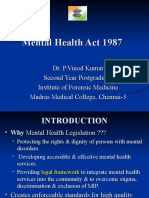Caarms Scale
Caarms Scale
Uploaded by
Adon RamaCopyright:
Available Formats
Caarms Scale
Caarms Scale
Uploaded by
Adon RamaCopyright
Available Formats
Share this document
Did you find this document useful?
Is this content inappropriate?
Copyright:
Available Formats
Caarms Scale
Caarms Scale
Uploaded by
Adon RamaCopyright:
Available Formats
Schizophrenia: earIy intervention and
assessment
RudoIf CardinaI
rudolf@pobox.com
Clinical Lecturer, Department of Psychiatry, University of Cambridge
Honorary SpR, Liaison Psychiatry, CPFT, Addenbrooke's
Cambridge MRCPsych course
da Darwin Hospital, Fulbourn
3.504.40pm, Tue 21 Feb 2012
Early intervention
Executive summary
A long duration of untreated psychosis (DUP) is associated with poorer
prognosis.
The hope is that early intervention |in psychosis| (EI) reduces DUP, and that
this improves the overall outcome Ior patients.
EI is distinct Irom standard care in two ways: (1) early detection; (2) treatment
speciIic to the early phase.
There has been strong governmental and NICE support Ior EI services.
Cochrane review (2011): 'There is emerging, but inconclusive, evidence that
people in the prodrome oI psychosis can be helped by some interventions.
There is some support Ior specialised early intervention services, but Iurther
trials would be desirable, and there is a question oI whether gains are
maintained. There is some support Ior phase-speciIic treatment Iocused on
employment and Iamily therapy, but again, this needs replicating with larger
and longer trials... at present we have insuIIicient data to draw any deIinitive
conclusions.
Duration of untreated psychosis (DUP) and prognosis
Marshall et al. (2005).
Meta-analysis: 26 studies; total n 4490;
prospective cohorts; Iirst-episode
psychosis.
Longer DUP associated with worse
outcomes at 6 and 12 months (total
symptoms, positive symptoms, negative
symptoms, depression/anxiety, overall
Iunctioning, social Iunctioning, chance
oI remission).
Generally not Iully explicable by
premorbid Iunctioning, where measured.
Why?
Direct 'toxicity oI psychosis?
ConIound? e.g. maybe Iorms oI
psychosis characterized by insidious
onset and social withdrawal cause (a)
poorer outcome, and independently (b)
delayed presentation and thereIore
longer DUP
Early intervention: government policy
NHS Plan (2000): required mental health services to establish early
intervention services Ior 14-35yo patients with a Iirst presentation oI psychotic
symptoms, and 14-35yo patients during the Iirst 3 y oI psychotic illness.
Mental Health Policy Implementation Guide (2001): set out tasks Ior early
intervention services, including
'reducing stigma and raising awareness oI symptoms oI psychosis to
reduce the duration oI untreated illness;
developing engagement, providing evidence-based treatments and
promoting recovery Ior young people who have experienced an episode oI
psychosis;
and working across the traditional divide between child and adolescent
services and adult services as well as in partnership with primary care,
education, social services, youth and other services.
NICE (2009) Commissioning Guide: 'The key components oI a
schizophrenia service are: early intervention and early treatment...
Dept of Health (2011): 'We... know that taking the right action through early
intervention can make a long-lasting diIIerence to people`s lives... we will...
prioritise early intervention across all ages.
Early intervention: NCE guidance on schizophrenia
NICE (2002): 'Because many people with actual or possible schizophrenia
have diIIiculty in getting help, treatment and care at an early stage, it is
recommended that early intervention services are developed to provide the
correct mix oI specialist pharmacological, psychological, social, occupational
and educational interventions at the earliest opportunity. (Grading of
recommendation. Good practice point [based on the clinical experience of
the guideline development group].)
NICE (2009) on NICE (2002): 'No high-quality evaluation oI the impact oI
early intervention services on the initial treatment oI psychosis was available.
But ethical.
NICE (2009): 'Offer early intervention services to all people with a first
episode or first presentation of psychosis, irrespective oI the person`s age or
the duration oI untreated psychosis. ReIerral to early intervention services may
be Irom primary or secondary care. Early intervention services should aim to
provide a full range of relevant pharmacological, psychological, social,
occupational and educational interventions for people with psychosis,
consistent with this guideline.
What is an E service intended to achieve? (DH 2001)
What does an E service look like? (DoH 2001) (1)
For population 1 million: ~150 new cases/year; ~450 caseload total; divided into
teams with caseload 120150. One team looks like:
What does an E service look like? (DoH 2001) (2)
What does an E service do? (DoH 2001) 1: general
Raising awareness of psychotic illness (community-based programs to
reduce stigma; symptoms awareness programmes Ior primary case,
educational institutions, social services, etc.)
Focus on symptoms (understand normality; know the variety oI
psychotic symptoms; encourage reIerral based on suspicion not certainty
oI psychosis; Iocus treatment on symptom management; 'watch and wait
when diagnosis unclear)
Age-, culture-, and gender-sensitive service
What does an E service do? (DoH 2001) 2: assessment (a)
What does an E service do? (DoH 2001) 2: assessment (b)
What does an E service do? (DoH 2001) 2: assessment (c)
What does an E service do? (DoH 2001) 3: interventions (a)
What does an E service do? (DoH 2001) 3: interventions (b)
'low dose or atypical: FGA: e.g. haloperidol 14 mg/day, .
SGA: risperidone 24 mg/d, quetiapine 350400 mg/d, olanzapine 520 mg/d,
aripiprazole.
No clear superiority (FGA more EPS, SGA more metabolic side eIIects).
What does an E service do? (DoH 2001) 3: interventions (c,d)
What does an E service do? (DoH 2001) 3: interventions (e)
What does an E service do? (DoH 2001) 3: interventions (f)
What does an E service do? (DoH 2001) 3: interventions (g)
What does an E service do? (DoH 2001) 3: interventions (h,i)
What does an E service do? (DoH 2001) 3: interventions (j)
What does an E service do? (DoH 2001) 3: interventions (k)
What does an E service do? (DoH 2001) 3: interventions (l)
Potential benefits of E
Improving outcome in first-episode psychosis (by detection and
phase-speciIic treatment).
E evidence: improving outcome in first-episode psychosis?
Biggest study: integrated treatment (specialized team) v. standard care (OPUS-
Scandinavia, RCT, n 547) Ior 2 years (with Iollow-up also at 5y):
leaving study early: Iewer people leIt in the specialized team group
attempted suicide: NS
compliance with treatment improved at 1y (RR stopped 0.20, NNT 9);
NS at 2y
GAF symptom scores: Iavoured specialized team at 1y, NS by 2y,
equivocal at 5y
GAF function scores: NS at 1y, Iavoured specialized team by 2y,
equivocal at 5y
user satisfaction Iavoured specialized team
number oI days in hospital at 1 year, 2y, 5y: NS
'has been hospitalized (yes/no) by 5 years: NS
~living independently: NS at 1y, NS at 2y; by 5 years Iavoured
integrated treatment (RR 0.42, NNT 19)
unemployment: NS at 1y, Iavoured integrated treatment at 2y (RR 0.72,
NNT 11), equivocal at 5y
E evidence: improving outcome in first-episode psychosis? 2
Family therapy plus a specialised team Ior relapse: no eIIect (Netherlands);
eIIect (China, RR Ior readmission 0.28, NNT 3).
Vocational intervention: employment likelier (RR 0.39, NNT 2, Australia)
Other small studies:
CBT, Ior suicidality }
CBT, Ior hospitalization }
Ethyl-eicosapentaenoic acid, Ior response }
BrieI intervention, Ior admission } NS
Adherence Coping Education }
Cannabis and psychosis therapy }
Crisis assessment, Ior hospitalization }
Behavioural intervention, Ior weight }
E evidence: improving outcome in first-episode psychosis? 3
'Whilst there is a compelling theoretical case Ior early intervention, much
oI the supporting evidence is circumstantial (based on the correlation
between duration oI untreated psychosis and outcome) rather than
deIinitive (based on improved outcome in clinical trials). II this
discrepancy persists, the obvious risk is that, eventually, early intervention
will become routine practice, without its eIIicacy ever being deIinitively
established.
(Marshall & Rathbone 2011.)
Potential benefits of E
Improving outcome in Iirst-episode psychosis (by detection and
phase-speciIic treatment).
Prevention of psychosis for people with prodromal symptoms.
Psychotic prodrome (1)
Prodromal or prepsychotic symptoms include
a disturbance in the perception oI selI;
overvalued (attenuated delusional) ideas;
extreme preoccupation with overvalued ideas (including philosophical and
mystical or religious themes);
disturbances oI simple perception (euch as unusually vivid perception, and
distorted body perception);
attenuated (brieI or mild or simple) hallucinations;
mild thought disorder (diIIiculty with conc
n
/memory/thought Ilow);
emotional disturbances (depression, suicidal ideation, anxiety, panic, mood
instability, social anxiety, sleep disturbance, tension or restlessness,
irritability or rage);
a Ieeling oI loss oI inner control;
and coping responses (such as alcohol or drug use, social isolation, or
trying to socialize to cope).
Behavioural indications oI a prodromal state include leaving or truanting Irom
school, university, or a job; marked and lasting shiIt oI interests; marked and
lasting social passivity, withdrawal, or isolation; and a marked and lasting
change in global appearance or behaviour.
Some cognitive impairment may already be present.
Psychotic prodrome (2): typical operational criteria
Yung`s ~Ultra High Risk (UHR) criteria, assessed by the Comprehensive
Assessment of At Risk Mental State (CAARMS) tool: any oI
attenuated psychosis within the previous 12 months (either oI subthreshold
intensity or subthreshold Irequency Ior the diagnosis oI a psychotic disorder),
brieI limited intermittent psychotic symptoms (BLIPS) lasting 1 week that
spontaneously resolved within the previous 12 months, or
'trait and state risk Iactors: a 'trait vulnerability (a presumed genetic
vulnerability to psychosis: Iirst-degree FH oI a psychotic disorder or
schizotypal personality disorder in patient) plus persistent low general
Iunctioning Ior at least 1 month within the previous 12 months.
There are other criteria Ior the prodrome; one set (Ior ~psychosis risk
syndrome) is proposed in the draIt DSM-V.
Early study: sensitivity 8392 and speciIicity 6274 Ior predicting the
development oI (Iull-blown) psychosis (e.g. Yung et al. 2003, 2005, 2006).
However, ~76 of UHR patients made no transition to psychosis over 640
months (Simon et al. 2011 systematic review) |PPV 24|. Ethics of
treatment?
Diversion: classification table
From that sensitivity/speciIicity/PPV, the implied prevalence is about 10
(above background, pre-selection effect). Imagine 1000 people:
DISEASE DISEASE
present (104) absent (896)
TEST positive 91 287
(378) (true+) (false+, T1err)
... PPV [P(present|+)]: 0.24
TEST negative 13 609
(622) (false-, T2err) (true-)
... NPV [P(absent|-)]: 0.98
Sensitivity: Specificity:
[P(+|present)] [P(-|absent)]
0.88 0.68
E evidence: intervention in the prodrome?
olanzapinenonspeciIic supportive therapy (NSST) v. placeboNSST
(PRIME-USA): NS Ior conversion to psychosis
CBTNSST v. NSST (EDIE-UK, EIPS-Germany): NS Ior conversion to
psychosis
risperidone+CBTspecialized team (ST) v. ST (PACE-Australia): active
group less likely to develop psychosis at 6 months (NNT 4); NS at 12 months.
(Delaved, not prevented?)
amisulprideneeds-Iocused interventions (NFI) v. NFI (LIPS-Germany, NB
open label): PANSS positive symptom scores and Global Assessment oI
Functioning Iavoured amisulpride at 3 months
omega-3 fatty acids v. placebo (Amminger-Austria): essential Iatty acid group
less likely to develop psychosis than placebo (NNT 6) over 3 months
(Marshall & Rathbone 2011, Cochrane review. Their conclusion. further
evidence needed before firm recommendations possible.)
Even earlier intervention: prevention of psychosis?
Primary prevention, via population-modiIiable risk Iactors.
No established methods.
Some correlative studies raise the possibility. For example.
Psychotic symptoms in 33,000 Swedish women (general population;
Hedelin et al. 2010 PMID 20504323):
relative risk oI high-Irequency symptoms 0.53 in those eating Iish 34
times/week, compared to those who never ate Iish
RR 0.78 Ior high (versus low) omega-6 polyunsaturated Iatty acids
Iatty Iish: lowest risk at intermediate level oI consumption
RR 0.63 Ior high (versus low) vitamin D intake
Vitamin D supplementation in Iirst year oI liIe in Finland (birth year 1966,
n9,114; McGrath et al. 2004 PMID 14984883):
irregular or regular vitamin D supplementation reduced risk oI later
schizophrenia (RR 0.08 and 0.12 respectively, compared to none)
2,000 IU/day had Iurther RR oI 0.23 compared to lower doses
Assessment
Assessment of psychosis: key factors
Establishing the presence and nature oI psychosis (and any other symptoms).
(Historv, collateral, MSE.) Consider rating scales (such as BPRS, PANSS,
SAPS/SANS).
ReIerral: (a) to secondary psychiatric care; (b) to early intervention services.
Diagnosing the cause(s). (Historv, collateral, MSE, phvsical exam, Ix.)
Appreciation oI the broader context the patient is in: biological, psychological,
social Iactors (which overlap!). Think about the impact on disease
(predisposing, precipitating, perpetuating Iactors), the impact of disease (e.g. on
social Iunctioning, physical health), and protective/relieving Iactors.
Engagement, rapport and therapeutic relationship (patient and Iamily/Iriends;
psychiatrist and multidisciplinary team).
Assess risks: selI-harm, harm to others, risks to physical health.
Treatments. For schi:ophrenia (NICE), start with: antipsychotic drug with
appropriate monitoring, interventions regarding recreational drug use, CBT,
Iamily intervention, consider arts therapies, regular physical health monitoring.
. and remember the E policy (DH 2001):
Eliciting psychotic symptoms: examples from the PSE (1)
Hallucinations
I should like to ask you a routine question which we ask oI everybody. Do you
ever seem to hear noises or voices when there is no one about, and nothing else
to explain it?
Have you had visions, or seen things other people couldn`t see?
Is there anything unusual about the way things Ieel or taste or smell?
Other perceptual abnormalities
Do you ever get the Ieeling that something odd is going on which you can`t
explain?
1hinking, thought reading/insertion/echo/broadcast
Can you think clearly or is there any interIerence with your thoughts?
Are you in Iull control oI your thoughts?
Can people read your mind?
Is anything like hypnotism or telepathy going on?
Eliciting psychotic symptoms: examples from the PSE (2)
Delusions
Do you Ieel under the control oI some Iorce or power other than yourselI?
Do people seem to drop hints about you or say things with a double meaning,
or do things in a special way so as to convey a meaning?
Do things seem to be specially arranged?
Is someone deliberately trying to harm you, such as trying to poison you or kill
you?
Do you think that people are organising things specially to help you?
Is there anything special about you? Do you have special abilities or powers?
Are you a very religious person?
How do you explain the things that have been happening? (SPECIFY) Is
anything like hypnotism, telepathy, or the occult going on? What is the
explanation?
Do you have any reason to be jealous oI anybody?
Have you had any unusual experience or adventure recently?
Do you have committed a crime, or sinned greatly, or deserve punishment?
Do you think your appearance is normal? Is there anything the matter with your
brain? Is there anything the matter with your body?
Do you have the Ieeling that something terrible is going to happen?
Eliciting psychotic symptoms: examples from the PSE (3)
Delusion or overvalued idea?
Even when you seem to be most convinced, do you really Ieel in the back oI
your mind that it might well not be true, that it might be imagination?
For a likely delusion:
How did it come into your mind that this was the explanation? (Did it happen
suddenly? How did it begin?)
Insight
Do you think there is anything the matter with you?
What do you think it is? Could it be a nervous condition? What do you think
the cause is? Why did you need to come to hospital?
Do you think (specifv delusions or hallucinations) were part oI a nervous
condition?
Eliciting psychotic symptoms (4)
Keks & Blashki (2006).
Good summarv.
(Though not evervthing listed as a 'svmptom of
psvchosis` here is a svmptom of psvchosis')
Read the ICD-10
original, too.
(simple schi:ophrenia.
CD for 1 vear)
Psychosis. "t's schizophrenia. s it?
Know what else it might be. Think in categories. Some examples:
Primarv psvchiatric. AIIective (manic, depressive) psychosis (can have
Schneiderian Iirst-rank symptoms). SchizoaIIective disorder. Persistent
delusional disorder. Acute and transient psychotic disorders. Personality
disorders with stress-induced psychotic symptoms.
Toxins, e.g. drug-induced psychosis (recreational, therapeutic).
Delirium, which isn`t a Iinal diagnosis (carry on...).
Developmental disorders, e.g. velocardioIacial syndrome.
Neurodegenerative disorders, e.g. Alzheimer`s disease, Irontotemporal
dementia, Huntington`s disease.
Focal neurological disease, e.g. stroke, tumours, epilepsy-associated psychosis,
multiple sclerosis.
Infection, e.g. viral encephalitis, malaria.
Autoimmune, e.g. systemic lupus erythematosus, anti-NMDA receptor
encephalitis.
Endocrine (e.g. severe thyroid disease).
Metabolic (e.g. porphyria, NiemannPick C, hypercalcaemia).
Nutritional (e.g. pellagra).
. etc.
Too detailed
Ior exams!
tinyurl.com/diagnosisofpsychosis
Declaration of interest.
Early ntervention within CPFT
Schizophrenia in the exams
Paper 1: cat
A patient saw a cat cross the road and knew immediately that there was a
conspiracy by the government to kill him. What is this psychopathological
phenomenon termed?
A. passivity phenomenon
B. phobia
C. delusional mood
D. delusional perception
E. Iunctional hallucination
Paper 1: smaller
Which structure is proportionally smaller in schizophrenia?
A. Lateral ventricles
B. Striatum
C. LeIt inIerior Irontal lobe
D. PreIrontal cortex
E. Hippocampus
Paper 1: passivity
A young man has passivity phenomena and third-person auditory hallucinations.
Which is the most likely risk Iactor?
A. losing mother beIore age 14
B. alcohol abuse
C. HLA-DQB1/DQA1
D. immigrant status
E. childhood sexual abuse
Paper 1: poison
You are interviewing a patient Ior the Iirst time. She tells you that her neighbours
have given her a poison that has made her intestines stop working. Which should
you do?
A. Ask her to tell you more about the problem.
B. OIIer blood tests, an intestinal workup.
C. Agree that some poisons can do this.
D. Tell her that this is very unlikely.
E. Suggest she contact the police.
Paper 1: F20
Which oI these is not classiIied under F20 (Schizophrenia) in ICD-10?
A. disorganized schizophrenia
B. post-schizophrenic depression
C. schizoaIIective disorder
D. residual schizophrenia
E. simple schizophrenia
Paper 1: direction
A patient shows marked changes in direction oI thought between grammatically
correct, coherent individual sentences. What is this termed?
A. Deviation
B. Derailment
C. Drivelling
D. Verbigeration
E. Wittering
Paper 1: febrile
A young man was admitted Ior treatment oI an acute psychotic episode 3 days
ago. Today you Iind him Iebrile and sweating with tachycardia and muscular
rigidity. Which is the most likely diagnosis?
A. hyperthyroidism
B. varicella zoster virus encephalitis
C. serotonin syndrome
D. neutropenic sepsis
E. neuroleptic malignant syndrome
Paper 1: persecution
A man is admitted to your unit. He has delusions oI persecution and Ieels guilty
about past misdeeds. He also complains oI low mood, and his concentration is
poor; he does not enjoy his customary pursuits. His appetite is reduced, he has lost
weight, and he is not sleeping well. What is the most likely diagnosis?
A. depressive episode
B. schizophrenia
C. bipolar aIIective disorder
D. hyperparathyroidism
E. delusional disorder
Paper 1: out loud
A patient has the experience oI hearing his own thoughts out loud a Iew seconds
aIter he thinks them. What is this termed?
A. Gedankenlautwerden
B. Gegenhalten
C. Mitmachen
D. Vorbeigehen
E. Wahnstimmung
Paper 1: choice of therapy
A. cognitivebehavioural therapy
B. dialecticalbehavioural therapy
C. Iamily intervention
D. cognitiveanalytical therapy
E. eye movement desensitization
F. psychodrama
G. relationship counselling
H. motivational interviewing
I. Gestalt therapy
Which would you advise Ior (pick ONE each):
A young man with bizarre delusions and social withdrawal who is just being
discharged Irom hospital; his mother thinks he`s lazy.
...
Paper 1: thought disorder
A. Fusion
B. Asyndesis
C. Condensation
D. Drivelling
E. Substitution
F. Clang association
G. Neologism
H. Tangentiality
I. Perseveration
Which ONE?
* A major thought stops and is replaced by a minor thought.
* Heterogeneous elements oI thought are interwoven with each other.
* There is a lack oI connection between successive thoughts.
Paper 2: kinetics (sic)
A drug has zero-order kinetics. How many halI-lives does it take to reach steady
state?
A. 3
B. 5
C. 7
D. 9
E. 11
Paper 2: least likely
Which is LEAST likely to be true oI schizophrenia?
A. Prenatal inIections predispose to schizophrenia.
B. Visual hallucinations do not invalidate the diagnosis.
C. Abnormalities on neurological examination are consistent with the diagnosis oI
schizophrenia.
D. Dopamine and glutamate abnormalities contribute to the development oI
psychosis.
E. Tau mutations cause schizophrenia.
Paper 2: comorbid
A patient with schizophrenia has liver disease and a glomerular Iiltration rate oI
120 ml/min. He needs an antipsychotic. Pick the best:
A. chlorpromazine
B. clozapine
C. olanzapine
D. amisulpride
E. risperidone
Paper 2: Hayling
A patient with schizophrenia has read that schizophrenics perIorm badly on the
Hayling test, and asks you to explain this to him. What process does it test?
A. visual short-term memory
B. phonological priming
C. immediate recall
D. delayed recall
E. response inhibition
Paper 2: family
Here are some Irequencies:
A) 15
B) 515
C) 1525
D) 2535
E) 3545
F) 4555
G) 5565
H) 6575
I) 7585
J) 8595
A 30-year-old woman has had bizarre delusions and disorganised speech. She has
now recovered and asks you about risks to her Iamily. What is the risk oI the
same condition developing in (pick ONE each):
her healthy 12-year-old son when he is an adult?
her 28-year-old sister?
her sister`s son, who has Down`s syndrome, when he is adult?
Paper 2: mutations
A) microtubule-associated protein tau (MAPT)
B) DISC1
C) dysbindin (DTNBP1)
D) Notch
E) presenilin 1
F) presenilin 2
G) leucine-rich repeat kinase 2 (LRRK-2)
H) neuregulin-1 (NRG1)
I) alpha-synuclein (SNCA)
J) PTEN-induced putative kinase 1 (PINK-1)
Mutations oI which genes are associated with:
Schizophrenia (THREE)?
Paper 3: design
Subjects are recruited to a randomized controlled trial oI psychosis and given new
treatment drug X or usual treatment oI chlorpromazine. Patients are randomly
allocated to one oI the two treatments. In this study, 15 oI patients given drug X
decide to stop and switch to the usual treatment, and oI those that remain, 120 out
oI 300 have extrapyramidal side eIIects and the treatment is eIIective in 55. In
contrast, all patients given chlorpromazine Iinish the study, and oI them, 225 out
oI 450 have extrapyramidal side eIIects and the treatment is eIIective in 60.
What should be done about the patients that were allocated to treatment X but
dropped out?
a) they should be analysed as iI they had continued on drug X
b) they should be analysed as iI they had been in the control group
c) their data should be dropped Irom the study entirely
d) their data should be replaced by data Irom randomly selected patients on drug
X who completed the study
e) their data should be replaced by the mean Iinal measure Ior patients on drug X
who completed the study
Paper 3: schizophreniform
Which oI the Iollowing diseases can cause a schizophreniIorm psychosis?
A. acromegaly
B. generalized anxiety disorder
C. anorexia nervosa
D. Huntington`s disease
E. severe pain
Paper 3: learning disability
What is the risk oI schizophrenia in someone with learning disability?
A. 1
B. 3
C. 5
D. 7
E. 9
CASC
STATION 1.
Mr John Hathawav is a 16-vear-old who has been referred to vou bv his GP, who
is concerned he mav have psvchotic svmptoms.
* Assess his mental state.
* In the next station, you will discuss your management plan with your consultant.
STATION 2.
Relevant phvsical examination and investigations are all normal.
* Discuss the case and your management plan with Dr Wilbur, your consultant.
References (PMD = PubMed D)
Systematic reviews. Marshall M, Rathbone J (2011). Early intervention Ior psychosis.
Cochrane Database of Svstematic Reviews 2011, Issue 6.
UK policy and NICE guidelines. UK Department oI Health (2011). No Health Without
Mental Health. // UK National Institute Ior Health and Clinical Excellence (2002/3).
Schi:ophrenia (National Clinical Guideline Number 1). // UK National Institute Ior
Health and Clinical Excellence (2009). Schi:ophrenia (National Clinical Guideline
Number 82). // DoH (2001). Mental Health Policv Implementation Guide. // NICE
(2001) CG1. Schi:ophrenia.
OPUS at 5y. Bertelsen et al. (2008) PMID 18606949.
Prodrome. Loewy et al. (2007). PMID 17459662. // Moller & Husby (2000). PMID
10755683. // Harvey (2009). PMID 19724764. // Yung et al. (2006). PMID 16630707. //
Yung et al. (2005). PMID 16343296. // www.dsm5.org // Yung et al. 2003 PMID
12505135; Yung et al. 2005 PMID 16343296; Yung et al. 2006 PMID 16630707 //
Simon et al. 2011 PMID 21784618.
Differential diagnosis. Cardinal & Bullmore (2011) The Diagnosis of Psvchosis, CUP.
Present State Examination (PSE). Wing et al. (1974), CUP.
DUP. Marshall et al. (2005). PMID 16143729. // Cunningham Owens et al. (2010).
PMID 20357306. // Lloyd-Evans et al. (2011). PMID 21972275.
Antipsychotic doses/recommendations. BAP guidelines: Barnes et al. (2011) PMID
21292923. Others: McGorry et al. (2011) Schi:. Res. Treat. // Schooler (2005) PMID
15863797 // GaIoor et al. (2010) PMID 20814318 // Chen et al. (2010) PMID
20724402 // Crespo-Facorro et al. (2011) PMID 21292922.
Paper 1: ANSWERS
Cat: D (delusional perception).
Smaller: not sure (somewhat duff question); E best? Hippocampus smaller (PMID 9596046,
meta-analysis); lateral ventricles larger (e.g. PMID 9850225); striatal sub-nuclei can be smaller
(15539860, 17306506, 19616411); lots oI cortical regions can be smaller (see 21312403).
Passivity: D? Diagnosis is SZ. A/B/C irrelevant. Immigrant status: incident rate ratios 2.3 (1
st
gen), 2.1 (2
nd
gen) (PMID 20663257). Childhood sexual abuse: data not as good; psychotic
disorders, RR ~2; schizophrenia, maybe closer to 1? (reviews PMID 22033827, 18003630).
Poison: A.
F20: C (schizoaffective disorder is F25); A is a synonym listed in ICD10 Ior F20.1
(hebephrenic SZ); B is F20.4; D is F20.5; E is F20.6.
Direction: B (derailment Entgleisen knight`s move).
Febrile: E (NMS).
Persecution: A. Depressive psychosis is the most likely.
Out loud: A. Gedankenlautwerden echo de la pensee hearing thoughts out loud. (Wikipedia
26/1/12 opts Ior Gedankenlautwerden hearing thoughts at the same time and e.d.l.p. hearing
thoughts after the thought, but historically they were simply coined in diIIerent countries,
translate to more or less the same thing, and have been used in overlapping ways, so caveat
Wikipedior.) (One oI the 'Ioreign languages questions.) (Blom 2010 A Dictionarv of
Hallucinations.)
Choice of therapy: probably C (family interventions). The question suggests schizophrenia;
CBT and Iamily interventions are eIIective; the question emphasizes (adverse) expressed
emotion, which is a predictor oI relapse, and a target oI Iamily interventions. (NICE CG82.)
Thought disorder: E (substitution), A (fusion), B (asyndesis loosening oI association).
Paper 2: ANSWERS
Kinetics: broken question. There`s no such thing as a halI-liIe when kinetics are
zero-order. (Zero-order kinetics like alcohol, e.g. ~1 unit metabolized per hour,
regardless oI starting level.) Don`t get upset more than brieIly; guess; move on.
(For first order kinetics, which is probablv what thev meant, the strictlv correct
answer is infinitv, but the practical answer is usuallv given as 5 half-lives, at
which point voure 1 0.5
5
97 of the wav to steadv state, so guess B).
Least likely: E (tau mutations); tau mutations cause Irontotemporal dementia
with parkinsonism (FTDP-17) and perhaps other tauopathies (PMID 18948254).
Comorbid: D (amisulpride). BNF: All antipsychotic drugs can precipitate coma
iI used in hepatic impairment; phenothiazines are hepatotoxic. BNF/eMC:
amisulpride is the best choice (weakly metabolised, renally excreted).
Hayling: E (response inhibition/suppression) is tested by the Hayling Sentence
Completion Test (complete the sentences // complete the sentences with a
nonsense word).
Family: B, B, A. SZ. Son children: 9.712.3. Sister siblings: 6.713.8.
Nephew with Down`s: harder. Nephew/nieces 2.3. Learning disability ~3,
Down`s speciIically ~1.6 (PMID 6996080, 1422617, 19267267 19048420.)
Mutations: B (DISC1), C (dysbindin), H (neuregulin).
Paper 3: ANSWERS
Design: A. The last-observation-carried-forward (LOCF) technique is the
standard measure in the psychiatric literature. (Not perIect, though: Saha & Jones
2008 doi:10.1016/j.jspi.2008.04.017)
Schizophreniform: D. Huntington`s disease can cause schizophreniform
psychosis; no evidence Ior the others. (PMID 8929949; Cardinal & Bullmore
2011.)
Learning disability: B. 3 would be a good overall estimate. (PMID
19267267 19048420, page 28, summarizes other studies with Irequencies, oI SZ
occurring in LD, oI 3.7, 6.2, 3.2, 3.4, 1.8, 3, 3, 1.3, and
|70.8,18.7,2.1, overall 8.3| depending on LD severity.)
You might also like
- A Client-Centered Approach To Difficult Client Experiences - Margaret S. WarnerDocument25 pagesA Client-Centered Approach To Difficult Client Experiences - Margaret S. WarnerBotezat-AntonescuRaduAndrei100% (2)
- Dass 42 ScalesDocument4 pagesDass 42 ScalesNur Riza MaulidinaNo ratings yet
- A Powerpoint Presentation On The Autism SpectrumDocument16 pagesA Powerpoint Presentation On The Autism SpectrumJane GilgunNo ratings yet
- Oxford Textbook of Old Age PsychiatryDocument7 pagesOxford Textbook of Old Age PsychiatryCengizhan ErNo ratings yet
- Wacp Primary Curriculum For Psychiatry PDFDocument5 pagesWacp Primary Curriculum For Psychiatry PDFowusuesselNo ratings yet
- Final ThesisDocument120 pagesFinal ThesisSingh SoniyaNo ratings yet
- Lpe2501 Writing Portfolio Task 1 (Brainstorm Form)Document3 pagesLpe2501 Writing Portfolio Task 1 (Brainstorm Form)Cik Yaya100% (1)
- Sample Substance Use Conceptualization and Treatment PlanDocument9 pagesSample Substance Use Conceptualization and Treatment PlanNORAZLINA BINTI MOHMAD DALI / UPM100% (2)
- Mini - ScanDocument37 pagesMini - Scandrkadiyala2No ratings yet
- The Meeting Link Between Emotional Intelligence, Rumination and Suicidal IdeationDocument4 pagesThe Meeting Link Between Emotional Intelligence, Rumination and Suicidal IdeationInternational Journal of Innovative Science and Research TechnologyNo ratings yet
- Ethical Issues in Clinical Forensic PsychiatryFrom EverandEthical Issues in Clinical Forensic PsychiatryArtemis IgoumenouNo ratings yet
- Mirtazapine PDF PDFDocument23 pagesMirtazapine PDF PDFBoneGrissleNo ratings yet
- Psychiatry Notes For PGDocument8 pagesPsychiatry Notes For PGskycall28100% (1)
- Assessment ToolsDocument74 pagesAssessment ToolsSharvari ShahNo ratings yet
- HTP OutlineDocument94 pagesHTP OutlineMuneeb_2kNo ratings yet
- Negative Symptoms in SchizophreniaDocument15 pagesNegative Symptoms in Schizophreniasyahrizon thomasNo ratings yet
- Nice Guidelinesnice GuidelinesDocument612 pagesNice Guidelinesnice GuidelinesAshok Kumar KrishnamoorthyNo ratings yet
- Testing The Glutamate Hypothesis of SchizophreniaDocument3 pagesTesting The Glutamate Hypothesis of SchizophreniaJohn000123No ratings yet
- Social Functioning ScaleDocument7 pagesSocial Functioning ScaleMihaela Cosmina NiculescuNo ratings yet
- D.P.M. & M.D. Psychiatry PapersDocument11 pagesD.P.M. & M.D. Psychiatry PapersRamashanker YadavNo ratings yet
- Equivalencia AntipsicóticosDocument4 pagesEquivalencia AntipsicóticosLuis Felipe Varela Espinoza100% (1)
- Frontal Lobe Syndromes: BackgroundDocument2 pagesFrontal Lobe Syndromes: BackgroundFausiah Ulva MNo ratings yet
- A Comparison Between The Mini Mental State Examination and The MoCA Test in SchizophreniaDocument6 pagesA Comparison Between The Mini Mental State Examination and The MoCA Test in SchizophreniaGuille NajarroNo ratings yet
- Bush-Francis Catatonia Rating ScaleDocument31 pagesBush-Francis Catatonia Rating ScaletamaraNo ratings yet
- Rehabilitation Rcpsych Report 2009Document46 pagesRehabilitation Rcpsych Report 2009psychforall100% (2)
- Stahl' Essential Psychopharmacology 273Document1 pageStahl' Essential Psychopharmacology 273Muhammad AzkaNo ratings yet
- Treatment Resistent Depression ArticleDocument6 pagesTreatment Resistent Depression Articlewaqas724No ratings yet
- Textbook of PsychiatryDocument3 pagesTextbook of PsychiatryDragutin PetrićNo ratings yet
- Very Early and Early Onset SchizophreniaDocument4 pagesVery Early and Early Onset SchizophreniaahmadreyhaanNo ratings yet
- Clinical Methods in Psychiatry 1st Ed 2024, AIIMS PublicationDocument527 pagesClinical Methods in Psychiatry 1st Ed 2024, AIIMS PublicationsanttoshmpattniNo ratings yet
- Brain Imaging in PsychiatryDocument7 pagesBrain Imaging in PsychiatryRoci ArceNo ratings yet
- Psychoanalysis in Modern Health PracticeDocument9 pagesPsychoanalysis in Modern Health PracticeMauroNo ratings yet
- I PSC PG Sud Comprehensive 2014Document531 pagesI PSC PG Sud Comprehensive 2014Kishore KumarNo ratings yet
- Aust N Z J Psychiatry 2014 Gitlin 89 90Document3 pagesAust N Z J Psychiatry 2014 Gitlin 89 90KThreopusNo ratings yet
- Assessment and Management of Agitation in Psychiatry Expert ConsensusDocument44 pagesAssessment and Management of Agitation in Psychiatry Expert ConsensusPablo RamirezNo ratings yet
- Posttraumatic Cognitions Inventory (PTCI)Document2 pagesPosttraumatic Cognitions Inventory (PTCI)Jessica KruminsNo ratings yet
- Young MRSDocument2 pagesYoung MRSAnonymous KgUtPlkjNo ratings yet
- Metacognitive TherapyDocument13 pagesMetacognitive Therapyzoey1mNo ratings yet
- Role of Homoeopathy in Psychological Disorders: January 2020Document6 pagesRole of Homoeopathy in Psychological Disorders: January 2020Madhu Ronda100% (1)
- Mrcpsych TipsDocument7 pagesMrcpsych Tipsmahadev4750% (2)
- Self Harm in AdolescenceDocument2 pagesSelf Harm in AdolescenceAmanda BrunerNo ratings yet
- The Clinical Interview and AssessmentDocument6 pagesThe Clinical Interview and AssessmentIoana Antonesi100% (1)
- Classification of Bipolar Affective DisordersDocument58 pagesClassification of Bipolar Affective Disordersdrkadiyala2No ratings yet
- Prodromal SchizophreniaDocument13 pagesProdromal SchizophreniadizhalfaNo ratings yet
- AntipsychoticsDocument36 pagesAntipsychoticsGlory MimiNo ratings yet
- Clinical Interviewing. BMA 2017 Psychiatry Book of The YearDocument2 pagesClinical Interviewing. BMA 2017 Psychiatry Book of The Yearjohnny chawNo ratings yet
- Ocd ReviewDocument4 pagesOcd ReviewneriNo ratings yet
- Consultation-Liaison Psychiatry (Psychosomatic Medicine) : M.Zainie Hassan A.RDocument25 pagesConsultation-Liaison Psychiatry (Psychosomatic Medicine) : M.Zainie Hassan A.RDavi DzikirianNo ratings yet
- Child and Adolescent Psychiatry, PrinciplesDocument8 pagesChild and Adolescent Psychiatry, PrinciplesClinica Monserrat100% (1)
- Conversion, Factitious Disorder and Malingering A Distinct Pattern or A ContinuumDocument10 pagesConversion, Factitious Disorder and Malingering A Distinct Pattern or A ContinuumPankhuri MishraNo ratings yet
- Psychiatry Practice BoostersFrom EverandPsychiatry Practice BoostersJesse KoskeyNo ratings yet
- Depression Conceptualization and Treatment: Dialogues from Psychodynamic and Cognitive Behavioral PerspectivesFrom EverandDepression Conceptualization and Treatment: Dialogues from Psychodynamic and Cognitive Behavioral PerspectivesChristos CharisNo ratings yet
- 12 PDFDocument201 pages12 PDFaastha jainNo ratings yet
- Ethical Dilemma in Psychiatry Real Cases Scenario (Perihan Elif Ekmekci) (Z-Library)Document155 pagesEthical Dilemma in Psychiatry Real Cases Scenario (Perihan Elif Ekmekci) (Z-Library)Dragutin PetrićNo ratings yet
- Lamotrigine in Psychiatric DisordersDocument10 pagesLamotrigine in Psychiatric DisordersastrogliaNo ratings yet
- AACN-American Academy of Clinical Neuropsychology-Practice - Guidelines PDFDocument23 pagesAACN-American Academy of Clinical Neuropsychology-Practice - Guidelines PDFErns Jean-baptisteNo ratings yet
- Mini Mental State - A Practical Method For Grading The Cognitive State of Patients For The ClinicianDocument10 pagesMini Mental State - A Practical Method For Grading The Cognitive State of Patients For The ClinicianIvana FasanoNo ratings yet
- The Effect of Venlafaxine Compared With Other Antidepressants and Placebo in The Treatment of Major DepressionDocument14 pagesThe Effect of Venlafaxine Compared With Other Antidepressants and Placebo in The Treatment of Major DepressionHakim Skoli100% (1)
- Child Psychiatric EmergenciesDocument8 pagesChild Psychiatric EmergenciesDanitza YhovannaNo ratings yet
- Behavioural AddictionsDocument15 pagesBehavioural AddictionsnishthasainiNo ratings yet
- The Extreme Male Brain Theory of AutismDocument7 pagesThe Extreme Male Brain Theory of Autismwhite_tea1100% (1)
- Scid 5 CVDocument26 pagesScid 5 CVZubair Mahmood KamalNo ratings yet
- AntidepressantsDocument17 pagesAntidepressantsVimal Bhagat100% (1)
- Psychdrugforpeds PDFDocument22 pagesPsychdrugforpeds PDFAnna HungNo ratings yet
- Detection of Malingering during Head Injury LitigationFrom EverandDetection of Malingering during Head Injury LitigationArthur MacNeill Horton, Jr.No ratings yet
- The Art and Science of Clinical Hypnosis, Why It Enhances Treatment So Well - Michael YapkoDocument8 pagesThe Art and Science of Clinical Hypnosis, Why It Enhances Treatment So Well - Michael YapkoarbetaNo ratings yet
- Unbreakable Minds Documentary AssignmentDocument6 pagesUnbreakable Minds Documentary Assignmentbonnie moenNo ratings yet
- Definition of Violent BehaviorDocument3 pagesDefinition of Violent BehaviorChristavani EfendiNo ratings yet
- Resume For E-PortfolioDocument3 pagesResume For E-Portfolioapi-254345179No ratings yet
- Local Media544435752678304395Document3 pagesLocal Media544435752678304395Lady Dianne SasaNo ratings yet
- Check List de Apraxia - TraduzirDocument13 pagesCheck List de Apraxia - TraduzirTamiris AlvesNo ratings yet
- Online Gaming Addiction Can CaDocument5 pagesOnline Gaming Addiction Can CaS PNo ratings yet
- Mental Status Examination (MSE)Document13 pagesMental Status Examination (MSE)Pia Mae Buaya100% (1)
- Malingering and Neurological Basis of Crime: Presented by Ayesha, Fiza, Sahar, UsmaniaDocument87 pagesMalingering and Neurological Basis of Crime: Presented by Ayesha, Fiza, Sahar, UsmaniaMehroba malik100% (1)
- Phobias Group PresentationDocument11 pagesPhobias Group PresentationHafsa MarufNo ratings yet
- Mental Health ACT Terms and AbbreviationsDocument2 pagesMental Health ACT Terms and AbbreviationsAsha ColmanNo ratings yet
- Solucionario Simulacro 4C3MDocument46 pagesSolucionario Simulacro 4C3MAngie Lm100% (3)
- The Therapuitic CommunityDocument3 pagesThe Therapuitic CommunityRajitha ChowdaryNo ratings yet
- Facebook Usage and Depression, Anxiety and StressDocument21 pagesFacebook Usage and Depression, Anxiety and StressDaniel John ArboledaNo ratings yet
- Homeopathic Alternatives To Conventional Drug TherapiesDocument239 pagesHomeopathic Alternatives To Conventional Drug Therapiesmr.mukundNo ratings yet
- Pendekatan Kaunseling Dalam Rawatan & Pemulihan Penagihan DadahDocument23 pagesPendekatan Kaunseling Dalam Rawatan & Pemulihan Penagihan Dadahadib emirNo ratings yet
- Draft - Cyber BullyingDocument3 pagesDraft - Cyber BullyingRazizy FauziNo ratings yet
- A Review of Neuropsychological and Neuroimaging Research in Autistic Spectrum Disorders: Attention, Inhibition and Cognitive FlexibilityDocument16 pagesA Review of Neuropsychological and Neuroimaging Research in Autistic Spectrum Disorders: Attention, Inhibition and Cognitive FlexibilityQuetzaly HernándezNo ratings yet
- A Psychoanalyst On The CouchDocument165 pagesA Psychoanalyst On The CouchFrancois RaffoulNo ratings yet
- Forensic PsychologyDocument43 pagesForensic PsychologyBismahNo ratings yet
- The Mental Status ExaminationDocument4 pagesThe Mental Status ExaminationMeow100% (1)
- Mental Health Act 1987Document35 pagesMental Health Act 1987P Vinod Kumar100% (1)
- 'Confusion of Tongues', Sandor FerencziDocument7 pages'Confusion of Tongues', Sandor FerencziMarie WalsheNo ratings yet
- Raskin 2018 CH 1Document32 pagesRaskin 2018 CH 1honghagiang.forworkNo ratings yet
- SW Practice With Individual and GroupsDocument355 pagesSW Practice With Individual and GroupsNithin SindheNo ratings yet

